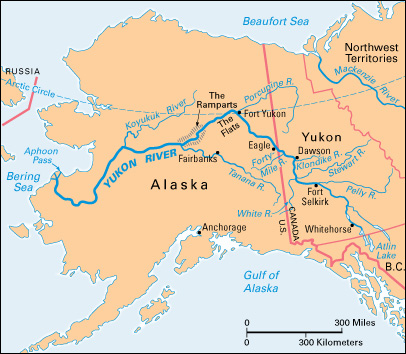Yukon River is one of the longest rivers in North America. It rises in far northwestern British Columbia, Canada. It flows across Canada’s Yukon territory and Alaska in the United States. About two-thirds of the river’s course is in Alaska, and about one-third is in Canada. The river’s total length is 1,979 miles (3,185 kilometers). The Yukon drains more than 330,000 square miles (855,000 square kilometers). About half of this area lies in Alaska.

The Yukon is navigable for almost its entire length. Before the late 1940’s, wood-burning stern-wheelers traveled from its mouth to Dawson in the Yukon territory. The Yukon was the principal transportation route during the early mining days of Alaska and the famous Klondike Gold Rush in the Yukon territory. But decreased mining activities and the convenience of air transportation have made shipping by boat unprofitable. Villagers that live along the river still use boats to transport freight and other necessities. The Yukon is frozen up to seven months of the year. Many of the small tributaries contain gold-bearing gravels. The eastern part has hot springs.
The course of the Yukon.
The Yukon River originates from a series of small lakes in northwestern British Columbia. It flows northwest and joins the Pelly River at Fort Selkirk, Yukon. The Yukon continues past Dawson and crosses the United States-Canada border near Eagle, Alaska. The river continues to flow northwest to Fort Yukon, where it begins flowing southwest. The Yukon then curves and flows northwest to the Bering Sea. The Yukon Valley is divided into two regions, the Upper Yukon and the Lower Yukon.
Upper Yukon.
The principal tributaries of the Upper Yukon are the Pelly, White, Stewart, Klondike, and Forty-Mile rivers. The first important discoveries of gold in this region were made on Forty-Mile Creek in 1895. But these were overshadowed a few years later by the richness of the Klondike field. Dawson, one of the largest settlements on the Upper Yukon, and the capital of the Yukon territory until 1953, stands where the Klondike and Yukon rivers meet.
After flowing northwest for 450 miles (724 kilometers), the Yukon turns almost at right angles and flows southwest for 200 miles (320 kilometers) through the famous “Flats.” These are level areas of sand bars and low islands, covered with spruce, willow, and birch. There, the river channel constantly shifts, and at seasons of high water it increases from a normal width of 10 miles (16 kilometers) to more than 40 miles (64 kilometers). The “great bend” of the Yukon is about 3 miles (4.8 kilometers) north of the Arctic Circle.
The “Flats” end at the Ramparts, a gorge that extends 110 miles (177 kilometers) to the mouth of the Tanana River. In this part, the Yukon Valley is 1 to 3 miles (1.6 to 4.8 kilometers) wide. The Tanana, the Yukon’s largest tributary entirely in Alaska, flows northwest for about 400 miles (640 kilometers), roughly parallel to and about 125 miles (201 kilometers) west of the Upper Yukon.
Lower Yukon.
The Ramparts gorge ends at the Tanana’s mouth. The Yukon River then enters a lowland about 25 miles (40 kilometers) wide. From this point to the sea, 800 miles (1,300 kilometers) away, the river valley is never less than 2 miles (3.2 kilometers) wide.
The Yukon delta covers nearly 9,000 square miles (23,000 square kilometers). The river has more than 20 outlets over 600 feet (180 meters) wide. But most of them are shallow and filled with sand bars. Steamers enter the delta through the Aphoon Pass, which is only 4 feet (1.2 meters) deep at low water.
